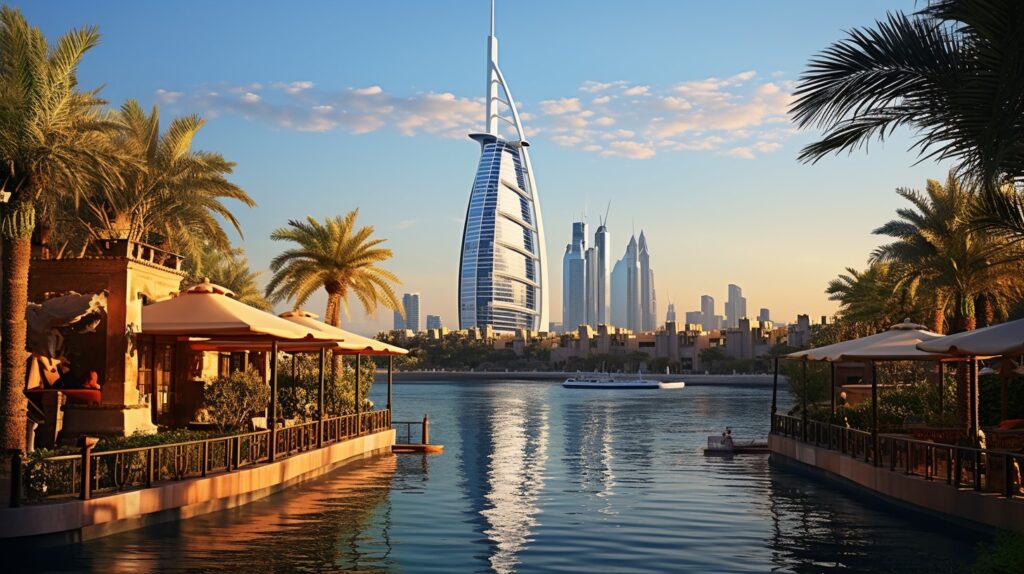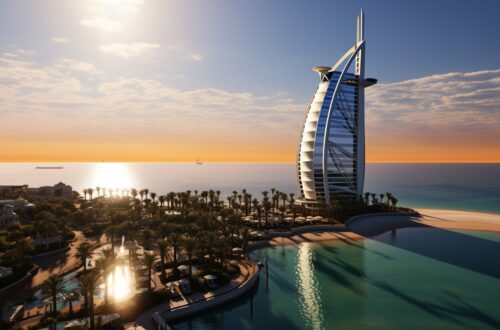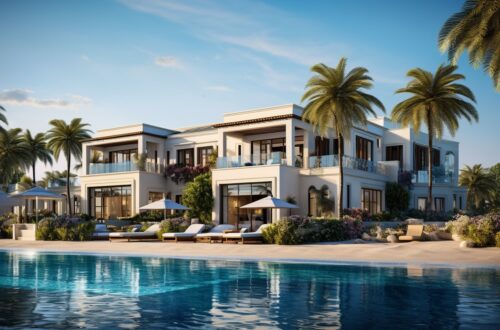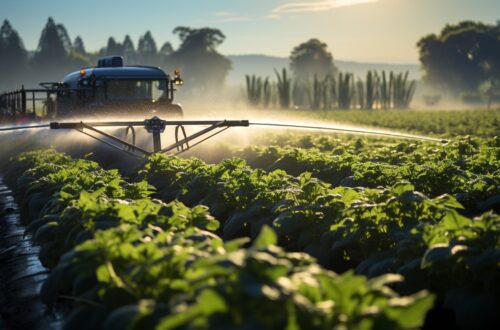Introduction to Climate Change in Dubai
In the sprawling desert metropolis of Dubai, climate change is manifesting as a relentless temperature increase. The city, which has transformed itself from a small trading port to a global business hub, now finds itself at the forefront of one of our time’s most pressing global issues. With summer temperatures already soaring above 40°C (104°F), the prospect of further increases poses significant challenges to the city’s infrastructure, economy, and the well-being of its residents. As a tourist destination known for its opulent hotels and sprawling shopping malls, Dubai’s response to climate change is an environmental imperative and a necessity to maintain its global appeal.

Impact of Rising Temperatures on Dubai’s Environment
Effects on the Desert Ecosystem
The increase in temperatures is profoundly impacting Dubai’s delicate desert ecosystem. The native flora and fauna, adapted to the harsh desert climate, are now under increasing stress due to the rising heat. This has led to changes in species composition and behavior, with potential long-term impacts on biodiversity. For visitors interested in the region’s natural landscape, this shift could mean a change in the desert experience, with fewer native species and altered landscapes.
Challenges for Urban Infrastructure and Public Health
The rising temperatures pose unique challenges for a city known for its architectural marvels, such as the towering Burj Khalifa and the sprawling Dubai Mall. The increased use of air conditioning to combat the heat leads to higher energy consumption, straining the city’s power grid. Furthermore, the extreme temperatures pose health risks, particularly for outdoor workers and those without access to adequate cooling.
Innovative Cooling Technologies
Development of Advanced Cooling Systems in Buildings
In response to the rising temperatures, Dubai has been at the forefront of developing and implementing advanced cooling technologies in its buildings. These technologies are not just about maintaining comfortable temperatures but are integral to the city’s sustainability efforts. High-efficiency HVAC systems, smart thermostats, and innovative building materials that reflect sunlight and reduce heat absorption are becoming the norm in new constructions.
Cooling Technologies in Burj Khalifa
The Burj Khalifa, the world’s tallest building, is a prime example of how advanced cooling technologies can be integrated into mega structures. The building employs a series of high-efficiency chillers and an intelligent building system that optimizes energy use. The tower’s exterior is designed to reflect sunlight, reducing the heat load on the building. A visit to the Burj Khalifa offers breathtaking views of the city and a glimpse into the cutting-edge technologies used to combat the challenges posed by climate change.
Sustainable Urban Planning and Architecture
In response to the rising temperatures and the broader challenges of climate change, Dubai has adopted a forward-thinking approach in its urban planning and architecture. This approach is centered around sustainability, aiming to create an urban environment that is not only resilient to the changing climate but also enhances the quality of life for its residents.
Integrating Green Spaces and Eco-friendly Design
One of the critical elements of Dubai’s sustainable urban planning is the integration of green spaces throughout the city. Parks, urban gardens, and green corridors are being developed to provide much-needed greenery in the desert landscape. These spaces offer numerous environmental benefits, including cooling the surrounding areas, improving air quality, and providing habitats for local wildlife. They also offer recreational and aesthetic value to residents and tourists alike. For example, Al Barari is an eco-friendly development in Dubai that features lush landscapes, waterways, and themed gardens, creating a serene environment that starkly contrasts the city’s arid surroundings.
Furthermore, Dubai’s architecture increasingly reflects sustainable design principles. Buildings are being designed with energy efficiency in mind, utilizing materials and techniques that reduce heat absorption and energy consumption. Reflective glass, natural ventilation systems, and shading structures are standard in new developments. These designs not only help reduce the reliance on air conditioning but also contribute to the overall sustainability of the urban landscape.
Promoting Walkability and Reduced Carbon Footprint in Urban Design
Dubai also creates more walkable neighborhoods to encourage a less car-dependent lifestyle. Developments like City Walk and The Walk at JBR are examples of areas designed with pedestrian-friendly amenities, shops, and dining options. By promoting walkability, these areas help reduce the carbon footprint associated with vehicular transportation and contribute to a healthier lifestyle for residents and visitors.
Renewable Energy Initiatives and Water Conservation
Dubai’s strategy to combat the effects of rising temperatures extends beyond urban design to include significant investments in renewable energy and water conservation – critical components in the city’s sustainability efforts.
Solar Energy Projects and Their Impact
A cornerstone of Dubai’s renewable energy initiatives is the Mohammed bin Rashid Al Maktoum Solar Park, one of the world’s most significant solar-powered projects. This ambitious project is expected to have a massive capacity to generate thousands of megawatts of electricity using solar power, significantly reducing the city’s reliance on fossil fuels. The solar park underscores Dubai’s commitment to sustainable energy and is a model for other regional towns. It represents a significant step forward in reducing carbon emissions and tackling the heat island effect in the city.
Strategies for Water Conservation in an Arid Climate
Water conservation is another crucial aspect of Dubai’s response to climate change. Efficient water management is vital in a region where water resources are scarce. Dubai has implemented several water conservation strategies, including reusing treated wastewater for irrigation and industrial purposes and deploying water-efficient fixtures in buildings. The city is also investing in desalination technology, which, while energy-intensive, is being made more sustainable by integrating renewable energy sources.
In conclusion, Dubai’s comprehensive approach to addressing rising climate change risks encompasses sustainable urban planning, innovative architectural designs, ambitious renewable energy projects, and adequate water conservation strategies. These efforts demonstrate Dubai’s commitment to sustainability and set a precedent for cities worldwide facing similar climatic challenges. For tourists and residents, these initiatives offer a glimpse into the future of sustainable living in an urban setting, where environmental considerations are intricately woven into the fabric of city life. The final sections of this article will explore Dubai’s public awareness and policy initiatives, as well as the challenges and future prospects in the city’s ongoing battle against climate change.

Public Awareness and Policy Initiatives
In tackling the challenges of rising temperatures and climate change, Dubai has recognized the importance of public awareness and comprehensive policy initiatives. These efforts are aimed at addressing the immediate concerns and fostering a long-term sustainable mindset among residents and visitors.
Government Policies and Regulations to Combat Climate Change
Dubai’s government has implemented a series of policies and regulations to reduce the city’s environmental impact and promote sustainable practices. The Dubai Clean Energy Strategy 2050 is a prime example, setting ambitious targets for renewable energy adoption and aiming to transform Dubai into a global center for clean energy and a green economy. This strategy includes plans to generate 75% of Dubai’s total power output from clean energy by 2050, significantly reducing the city’s carbon footprint.
Another critical policy is the Green Building Regulations and Specifications, which were introduced to ensure that new buildings adhere to energy-efficient and environmentally friendly standards. These regulations mandate the use of sustainable materials, energy-efficient design, and the incorporation of renewable energy in new constructions.
Educational Programs and Community Engagement
Dubai has also invested in educational programs and community engagement initiatives to raise public awareness about climate change and the importance of sustainability. These programs range from school curriculums, including environmental education, to community events focused on sustainability practices. For instance, the Dubai Electricity and Water Authority (DEWA) conducts regular workshops and campaigns to educate the public about energy conservation and water-saving techniques.
Additionally, events like the World Green Economy Summit, held annually in Dubai, bring together global leaders, experts, and the public to discuss sustainability challenges and solutions. These events offer a platform for knowledge exchange and are instrumental in raising awareness about environmental issues among the broader community.
Challenges and Future Prospects
While Dubai’s efforts in adapting to rising temperatures and climate change are commendable, the city faces ongoing challenges and must continually adapt to meet future environmental goals.
Balancing Rapid Urban Development with Environmental Sustainability
One of the primary challenges Dubai faces is balancing its rapid urban development with environmental sustainability. As the city continues to grow, with new buildings and infrastructure projects constantly underway, ensuring this sustainable development remains a significant challenge. Managing the environmental impact of such rapid growth, particularly in energy and water consumption, is critical for Dubai’s sustainable future.
The city must also contend with the environmental impact of its booming tourism industry. While tourism is a significant contributor to Dubai’s economy, it also brings challenges in terms of resource consumption and waste management. Developing sustainable tourism practices is essential for the city’s long-term environmental health.
Anticipating and Preparing for Future Climate Conditions
As climate change evolves, Dubai must anticipate and prepare for future conditions. This includes further temperature rises, initial changes in weather patterns, and the associated impacts on the city’s infrastructure and natural resources. Continued investment in research and development, particularly in renewable energy, water conservation, and sustainable urban planning, will be critical to Dubai’s ability to adapt to these changes.
Furthermore, Dubai’s role as a leader in sustainability in the region means that its strategies and successes can serve as a model for other cities facing similar challenges. The city’s prospects in the realm of sustainability will likely influence environmental strategy across the Middle East and beyond.
In conclusion, Dubai’s multi-faceted approach to addressing climate change – encompassing innovative infrastructure, policy initiatives, public awareness, and a commitment to sustainable development – positions it as a city at the forefront of environmental adaptation and sustainability. For residents and tourists alike, witnessing Dubai’s journey provides valuable insights into the potential for urban centers to adapt to climate change and thrive in doing so. As the city continues to evolve, its ongoing efforts and adaptations will be critical in shaping a sustainable and resilient future facing global environmental challenges.





